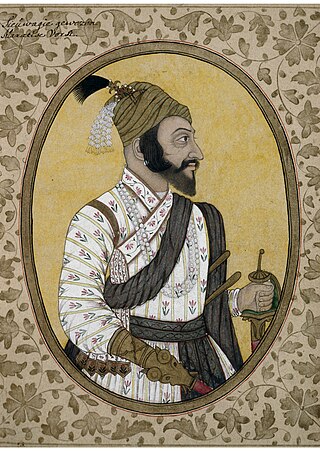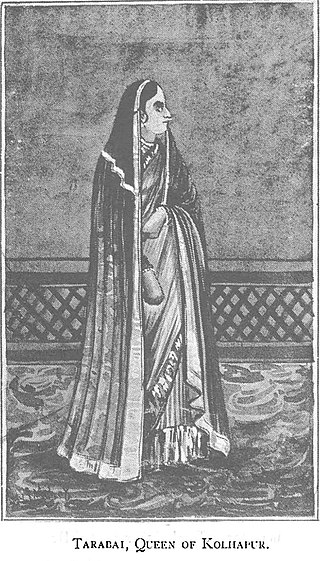
Shivaji I was an Indian ruler and a member of the Bhonsle Maratha clan. Shivaji carved out his own independent kingdom from the declining Adilshahi Sultanate of Bijapur that formed the genesis of the Maratha Empire. In 1674, he was formally crowned the Chhatrapati of his realm at Raigad Fort.

Sambhaji, also known as Shambhuraje was the second Chhatrapati of the Maratha Empire, ruling from 1681 to 1689. He was the eldest son of Shivaji, the founder of the Maratha Empire. Sambhaji's rule was largely shaped by the ongoing wars between the Maratha Empire and the Mughal Empire, as well as other neighbouring powers such as the Abyssinians of Janjira, Wadiyars of Mysore and the Portuguese Empire in Goa. After Sambhaji's death, his brother Rajaram I succeeded him as the next Chhatrapati and continued the Mughal–Maratha Wars.

Kolhapur is a city on the banks of the Panchganga River in the southern part of the Indian state of Maharashtra.

The Maratha Empire was an early modern Indian empire and later a confederation that controlled large portions of the Indian subcontinent in the 18th century. Maratha rule formally began in 1674 with the coronation of Shivaji of the Bhonsle dynasty as the Chhatrapati. Although Shivaji came from the Maratha caste, the Maratha empire also included warriors, administrators, and other nobles from the Maratha and several other castes from what is known today as Maharashtra. The Maratha Kingdom was expanded into a full-fledged Empire in the 18th Century under the leadership of Peshwa Bajirao I.

Peshwa was second highest office in the Maratha Confederacy, next in rank and prestige only to that of the Chhatrapati. Initially serving as the appointed prime minister in the Maratha empire, the office became hereditary after the death of Shahu in 1749. During the reign of Shahu, the office of Peshwa grew in power and the Peshwas came to be the de facto rulers of the Maratha empire. However following the defeat of the Marathas in 1761, the office of the Peshwa became titular as well and from that point onwards served as the ceremonial head of the Confederacy underneath the Chhatrapati.

Balaji Vishwanath Bhat (1662–1720) was the first of a series of hereditary Peshwas hailing from the Bhat family who gained effective control of the Maratha Empire and the Mughal vassals of the Marathas during the early 18th century. Balaji Vishwanath assisted a young Maratha king Shahu to consolidate his grip on a kingdom that had been racked by civil war and persistently intruded on by the Mughals under Aurangzeb. He was called the Second Founder of the Maratha State. He secured a grant from the Mughal court that confirmed Shahu as the legitimate Mughal vassal, at the expense of his rival Sambhaji. Later, his son Bajirao I became the Peshwa.

Tarabai Bhosale (née Mohite) was the regent of the Maratha Empire from 1700 until 1708. She was the queen of Rajaram I, and daughter-in-law of the empire's founder Shivaji I. She is acclaimed for her role in keeping alive the resistance against Mughal occupation of Maratha territories after the death of her husband, and acting as the regent during the minority of her son, Shivaji II.

Rashtrakuta was a royal Indian dynasty ruling large parts of the Indian subcontinent between the 6th and 10th centuries. The earliest known Rashtrakuta inscription is a 7th-century copper plate grant detailing their rule from Manapur, a city in Central or West India. Other ruling Rashtrakuta clans from the same period mentioned in inscriptions were the kings of Achalapur and the rulers of Kannauj. Several controversies exist regarding the origin of these early Rashtrakutas, their native homeland and their language.

Nashik district, also known as Nasik district, is a district in Maharashtra, India. The city of Nashik is the administrative headquarters of the district. Nashik is well known for the production of wine. Nashik is also known as Mini Maharashtra, because the climate and soil conditions of Surgana, Peth, Igatpuri resembles with Konkan. Niphad, Sinnar, Dindori, Baglan blocks are like Western Maharashtra and Yeola, Nandgaon, Chandwad blocks are like Vidarbha Region. Nashik is the biggest city in the district while Malegaon is the second biggest city. Manmad, Igatpuri, and Sinnar are some of the big cities situated in the Nashik District. Manmad is one of the biggest railway junctions in India while the city of Malegaon is famous for its powerloom.

North Karnataka is a geographical region in Deccan plateau from 300 to 730 metres elevation that constitutes the region of the Karnataka state in India and the region consists of 14 districts. It is drained by the Krishna River and its tributaries the Bhima, Ghataprabha, Malaprabha, and Tungabhadra. North Karnataka lies within the Deccan thorn scrub forests ecoregion, which extends north into eastern Maharashtra.

The History of Karnataka goes back several millennia. Several great empires and dynasties have ruled over Karnataka and have contributed greatly to the history, culture and development of Karnataka as well as the entire Indian subcontinent. The Chindaka Nagas of central India Gangas, Rashtrakutas of Manyakheta, Chalukyas of Vengi, Yadava Dynasty of Devagiri were all of Kannada origin who later took to encouraging local languages.

The political history of medieval Karnataka spans the 4th to the 16th centuries, when the empires that evolved in the Karnataka region of India made a lasting impact on the subcontinent. Before this, alien empires held sway over the region, and the nucleus of power was outside modern Karnataka. The medieval era can be broadly divided into several periods: The earliest native kingdoms and imperialism; the successful domination of the Gangetic plains in northern India and rivalry with the empires of Tamilakam over the Vengi region; and the domination of the southern Deccan and consolidation against Muslim invasion. The origins of the rise of the Karnataka region as an independent power date back to the fourth-century birth of the Kadamba Dynasty of Banavasi, the earliest of the native rulers to conduct administration in the native language of Kannada in addition to the official Sanskrit. This is the historical starting point in studying the development of the region as an enduring geopolitical entity and of Kannada as an important regional language.

The history of Madhya Pradesh can be divided into three periods - the ancient period, the medieval period and modern period.
Nashik is a historically, mythologically, socially and culturally important city in the northern part of the state of Maharashtra in India. It is known for the temples on the banks of the Godavari and it has historically been one of the holy sites of the Hindu religion. It is one of the four cities that hosts the massive Sinhastha Kumbh Mela once every twelve years.
Jawali is a small village located in the Mahadeva Mountain range of Phaltan Tehsil of the Satara district of the Indian state of Maharashtra.

The House of Mohite or Mohite clan is a prominent Maratha clan, that held significant positions as Senapati and Sardar within the Maratha Empire. The House of Mohite was established by Sambhaji Mohite, who served as the Subedar of Saswad and was the brother of Shahaji's wife, Tukabai. He was also the father of Soyarabai, who later became the wife of Chhatrapati Shivaji. His son Hambirrao Mohite became the Senapati of the Maratha Empire. The Mohite clan played significant role during the Mughal-Maratha wars.
Pisal is surname mainly found amongst the 96 Maratha clans.

Maharashtra is a state in the western region of India. It is India's second-most populous state and third-largest state by area. The region that comprises the state has a long history dating back to approximately 1300–700 BCE, although the present-day state was not established until 1960 CE.

The siege of Jinji,, began when the Mughal Emperor Aurangzeb appointed Zulfiqar Ali Khan as the Nawab of the Carnatic and dispatched him to besiege and capture Jinji Fort, which had been sacked and captured by Maratha Empire troops led by Rajaram, they had also ambushed and killed about 300 Mughal Sowars in the Carnatic. The Mughal Emperor Aurangzeb then ordered Ghazi ud-Din Khan Feroze Jung I to protect the supply routes leading to Jinji Fort and to support and provide reinforcements to Zulfiqar Ali Khan when needed.
Jayasimha was the first ruler of the Chalukya dynasty of Vatapi in present-day India. He ruled the area around modern Bijapur in the early 6th century, and was the grandfather of the dynasty's first sovereign ruler, Pulakeshin I.














